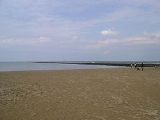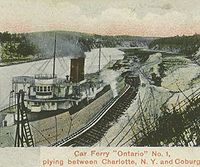
Charlotte, Rochester, New York
Encyclopedia

Rochester, New York
Rochester is a city in Monroe County, New York, south of Lake Ontario in the United States. Known as The World's Image Centre, it was also once known as The Flour City, and more recently as The Flower City...
located at the mouth of the Genesee River
Genesee River
The Genesee River is a North American river flowing northward through the Twin Tiers of Pennsylvania and New York. The river provided the original power for the Rochester area's 19th century mills and still provides hydroelectric power for downtown Rochester....
along Lake Ontario
Lake Ontario
Lake Ontario is one of the five Great Lakes of North America. It is bounded on the north and southwest by the Canadian province of Ontario, and on the south by the American state of New York. Ontario, Canada's most populous province, was named for the lake. In the Wyandot language, ontarío means...
. It is the home of the Port of Rochester and Charlotte High School.
Early Settlers
In 1788, the Mill Yard TractThe Mill Yard Tract
The Mill Yard Tract was a portion of the Phelps and Gorham Purchase of western New York State. It consisted of a tract deep and , abutting the west bank of the Genesee River stretching from the approximate locations of the present day town of Avon north to the community of Charlotte at Lake...
, a parcel of land approximately 12 miles (19.3 km) wide and 24 miles (38.6 km) long, along bank of the Genesee River stretching from present day locations of Charlotte at Lake Ontario through the City of Rochester was purchased from the Seneca Indians by Oliver Phelps
Oliver Phelps
Oliver Phelps was born in Poquonock, Connecticut and moved to Suffield, Connecticut, where he apprenticed to a local merchant. He shortly thereafter became a tavern keeper in Granville, Massachusetts. During the Revolution he was Deputy Commissary of the Continental Army and served until the end...
and Nathaniel Gorham
Nathaniel Gorham
Nathaniel Gorham was the fourteenth President of the United States in Congress assembled, under the Articles of Confederation...
.
During this time, the area between the river and Braddock Bay was still used as hunting grounds by the Seneca Indians. The first hut on the shores of Lake Ontario on the west side of the Genesee River was constructed in 1791 by William Hencher and his son who settled the land the next season with his wife and seven daughters.
These early settlements preceded the later permanent settlements at the village of Rochester.
In 1792 the Pulteney Association
The Pulteney Association
The Pulteney Association was a purchaser in 1792 of a large portion of the Western New York land tract known as the Phelps and Gorham Purchase. The Pulteney Associates were British investors: nine-twelfths was owned by Sir William Pulteney, 5th Baronet , a Scottish lawyer; two-twelfths by William...
purchased rights to much of Phelps and Gorham's land in New York. Colonel Robert Troup
Robert Troup
Robert Troup was an American soldier, lawyer and jurist.Born in Elizabethtown, New Jersey, Troup attended King's College...
, an agent of the Pulteney Association, arranged the first layout of the town, dividing the land into 1 acres (4,046.9 m²) lots. He named the area "Charlottesburgh" in honor of his daughter.
Lake Trade
The community once served as a port for international trade. Samuel Latta established a warehouse at the mouth of the Genesee river and in 1806 was appointed as customs collector of the Port of Genesee by President Thomas JeffersonThomas Jefferson
Thomas Jefferson was the principal author of the United States Declaration of Independence and the Statute of Virginia for Religious Freedom , the third President of the United States and founder of the University of Virginia...
. Samuel Latta's brother, frontier merchant George Clinton Latta (1795–1871) ran a successful trading company from Charlotte, operating a fleet of schooner
Schooner
A schooner is a type of sailing vessel characterized by the use of fore-and-aft sails on two or more masts with the forward mast being no taller than the rear masts....
s engaging in trade across the Great Lakes
Great Lakes
The Great Lakes are a collection of freshwater lakes located in northeastern North America, on the Canada – United States border. Consisting of Lakes Superior, Michigan, Huron, Erie, and Ontario, they form the largest group of freshwater lakes on Earth by total surface, coming in second by volume...
.
Trade was interrupted during the War of 1812
War of 1812
The War of 1812 was a military conflict fought between the forces of the United States of America and those of the British Empire. The Americans declared war in 1812 for several reasons, including trade restrictions because of Britain's ongoing war with France, impressment of American merchant...
and a less exposed port was briefly established three miles upstream at Carthage Landing.
During the course of the war, British forces were encountered at Charlotte on several occasions. In June 1813, the British fleet under Sir James Yeo landed at Charlotte and confiscated supplies of grain, flour, pork and other stores which the residents surrendered without further incident. In September of that year, the British fleet was again spotted off shore, but was engaged and driven off by the American fleet of Commodore Isaac Chauncey
Isaac Chauncey
Isaac Chauncey was an officer in the United States Navy.-Biography:Chauncey, born in Black Rock, Connecticut, 20 February 1779, was appointed a Lieutenant in the Navy from 17 September 1798...
. Finally, in May 1814, the British attempted another landing, however, this time the citizens who had become aware of the British and Indian massacre at Lewiston, NY and the recent attack at Oswego, NY, dispatched the local militia to refuse landing. After a brief exchange of cannon fire, the fleet departed. In 1816, Colonel Caleb Hopkins was commissioned as brigadier general for gallant service during the war, including defending the Port of Charlotte against the British.
After the end of the war, trade began to rapidly increase. Some early settlers believed that Charlotte would become the major city along the Genesee River, until the use of the water falls to provide power to the mills and the arrival of the Erie Canal in 1823 later resulted in the dominance of the settlements at the City of Rochester.
In order to improve navigation, a stone light house was constructed in 1821 on the west bank, replaced later in 1880 by an Octagonal light on the west pier.
On August 25, 1852 ground was broken on the Rochester and Lake Ontario Railroad
Rochester and Lake Ontario Railroad
The Rochester and Lake Ontario Railroad was incorporated May 17, 1852; it was merged September 30, 1855, into the New York Central Railroad....
(later part of the New York Central Railroad
New York Central Railroad
The New York Central Railroad , known simply as the New York Central in its publicity, was a railroad operating in the Northeastern United States...
) which made its first run on May 12, 1853 in about thirty minutes. The railroad provided a convenient route for Canadian passages to reach New York City
New York City
New York is the most populous city in the United States and the center of the New York Metropolitan Area, one of the most populous metropolitan areas in the world. New York exerts a significant impact upon global commerce, finance, media, art, fashion, research, technology, education, and...
.
However, lake trade from Charlotte began to decline from increased competition from the Erie Canal
Erie Canal
The Erie Canal is a waterway in New York that runs about from Albany, New York, on the Hudson River to Buffalo, New York, at Lake Erie, completing a navigable water route from the Atlantic Ocean to the Great Lakes. The canal contains 36 locks and encompasses a total elevation differential of...
and the railroad lines in Rochester.
Resort Era


American Civil War
The American Civil War was a civil war fought in the United States of America. In response to the election of Abraham Lincoln as President of the United States, 11 southern slave states declared their secession from the United States and formed the Confederate States of America ; the other 25...
, Charlotte rebounded as a summer resort with the arrival of several excursion steamers and with organization of the Genesee Yacht Club in 1874. The Ontario Car Ferry company began operating a ferry service for passengers and cargo from the port in November 1907 with the launch of the "Ontario I" later joined by the "Ontario II" as well as the "Toronto" and the "Kingston". These large ferries prompted a need to deepen the channel and make harbour improvements.
In 1884, the Ontario Beach Improvement Company was formed to establish lake front resort area and by 1889 electric trolleys were connecting vacationers to the City of Rochester.
Charlotte was annexed by the city of Rochester in 1916 in an effort by the city to gain control over the port and increase its population, thereby raising its political importance and funding. The port's activity again declined during the Great Depression
Great Depression
The Great Depression was a severe worldwide economic depression in the decade preceding World War II. The timing of the Great Depression varied across nations, but in most countries it started in about 1929 and lasted until the late 1930s or early 1940s...
. Ferry traffic eventual came to an end around 1949.
Another attempt to establish ferry traffic between Rochester and Toronto
Toronto
Toronto is the provincial capital of Ontario and the largest city in Canada. It is located in Southern Ontario on the northwestern shore of Lake Ontario. A relatively modern city, Toronto's history dates back to the late-18th century, when its land was first purchased by the British monarchy from...
was made with the launch of a fast ferry the Spirit of Ontario I which ran from 2004-2005. The fast ferry again spurred a round of investment in Charlotte and the port.
Miscellenea
- Charlotte is located at 83 metres (272.3 ft) above sea level.
- Charlotte Cemetery is the resting place of the daredevil Sam PatchSam PatchSam Patch , known as "The Yankee Leaper", became the first famous American daredevil after successfully jumping from a raised platform into the Niagara River near the base of Niagara Falls in 1829.-Biography:...
who first jumped Niagara FallsNiagara FallsThe Niagara Falls, located on the Niagara River draining Lake Erie into Lake Ontario, is the collective name for the Horseshoe Falls and the adjacent American Falls along with the comparatively small Bridal Veil Falls, which combined form the highest flow rate of any waterfalls in the world and has...
and died jumping the falls of the Genesee River in 1829.

